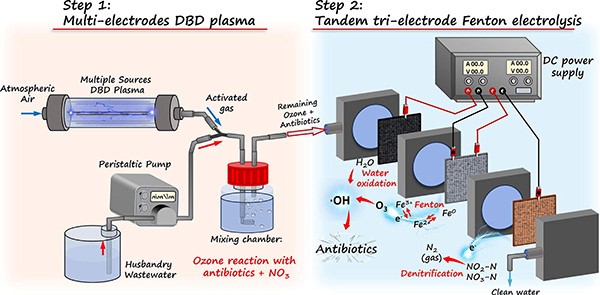Prof. Min Jang’s Team Develops Plasma Fenton Process for Water Purification
- admin
- 2024-11-11
- 1251
Professor Min Jang's Research Team (Department of Environmental Engineering) Develops a DBD Plasma Tandem Three-Electrode Fenton Process
For
Simultaneous Oxidation of Antibiotics and Denitrification of Nitrate-Nitrogen
in Water
- Published
in the Chemical Engineering Journal (JCR IF 13.4, JCR Rank: Top 3.1%) -

DBD Plasma Tandem Three-Electrode
Fenton Process
Kwangwoon University's research team, comprising Dr. Geondeok Hwang (first
author), Dr. Soyeon Yoon, Dr. Seokbeom Jang, Dr. Haslina Nu, Dr. Cho-eun Jong,
and Professor Min Jang (corresponding author, Deputy Director of PBRC, and
Director of JENTL) from the Department of Environmental Engineering, together
with Professor Eunha Choi from the Plasma Bio Center, developed a DBD plasma
tandem three-electrode Fenton process to simultaneously and effectively remove
antibiotics and nitrate-nitrogen from water, and identified the mechanism of
pollutant removal.
Ozone generated by dielectric barrier discharge (DBD) plasma has great
potential for water treatment; however, its application is limited due to its
low solubility and the resistance of certain pollutants to ozone. This study
optimized and investigated the mechanisms of a tandem three-electrode Fenton
(S-PEF) process combined with DBD plasma, designed to completely oxidize and
decompose commonly detected antibiotics in water―sulfamethoxazole (SMX),
amoxicillin (AMX), and norfloxacin (NOF)―under continuous water
flow conditions. Additionally, it enables the denitrification and reduction of
nitrate-nitrogen (NO3-N), a challenging contaminant frequently found
in groundwater, converting it to N₂.
The ozone-degradable antibiotics SMX and AMX are largely decomposed in the
DBD plasma gas within the mixing chamber. Any residual SMX and AMX, along with
NOF, which has high resistance to ozone, are fully eliminated by hydroxyl
radicals generated from ozone in the anode chamber of the tandem
three-electrode system. The continuous oxidation-reduction regeneration of
specialized Fe in the tandem three-electrode system prevents the formation of
secondary Fe sludge. Finally, in the cathode chamber containing copper oxide
nanowires, NO3-N and NO2-N are denitrified to N₂ with a selectivity of over 95%. This sequential
treatment process effectively mitigates the competitive effects of CO₃²? and humic acid in
wastewater through the oxidation action of hydroxyl radicals (·OH) generated
from ozone. The S-PEF process completely decomposed all antibiotics across a
wide range of water temperatures, outperforming standalone plasma treatment.
Toxicity was significantly reduced according to Ecological Structure-Activity
Relationship (ECOSAR) and E. coli sterilization toxicity assessments. Due to
its high cost-effectiveness, the S-PEF water treatment process holds promising
potential as an advanced technology for future wastewater and groundwater
treatment.
This research was supported by the Basic
Science Research Program through the National Research Foundation of Korea
(NRF), funded by the Ministry of Education and the Ministry of Science and ICT
(Grant No. 2021R1A6A1A03038785). The findings were published in the October 20,
2024, online edition of the Chemical Engineering Journal (IF: 13.4, JCR rank:
3.1%) under the title “Sequential DBD Plasma-Assisted Tandem Tri-Electrode
Fenton Process for Enhanced Antibiotics Treatment and Denitrification.”
Web link : https://doi.org/10.1016/j.cej.2024.156930
https://www.kw.ac.kr/ko/life/research.jsp?BoardMode=view&DUID=48144?